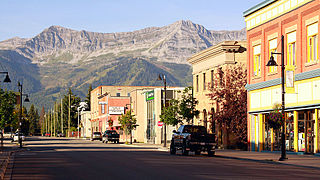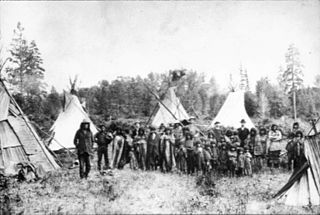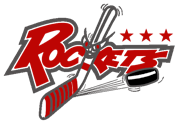
Fernie is a city in the Elk Valley area of the East Kootenay region of southeastern British Columbia, Canada, located on BC Highway 3 on the western approaches to the Crowsnest Pass through the Rocky Mountains. Founded in 1898 and incorporated as the City of Fernie in July 1904, the municipality has a population of over 5,000 with an additional 2,000 outside city limits in communities under the jurisdiction of the Regional District of East Kootenay. A substantial seasonal population swells the city during the winter months.

Invermere is a community in eastern British Columbia, Canada, near the border of Alberta. It is the hub of the Columbia Valley between Golden to the north and Cranbrook to the south. Invermere sits on the northwest shore of Windermere Lake and is a popular summer destination for visitors and second home owners from Edmonton and Calgary.

Sparwood is a district municipality in the Canadian province of British Columbia. It is the second-largest community on the Elk River.

The Kootenays or Kootenay is a region of southeastern British Columbia. It takes its name from the Kootenay River, which in turn was named for the Kutenai First Nations people.

The Kutenai, also known as the Ktunaxa, Ksanka, Kootenay and Kootenai, are an indigenous people of Canada and the United States. Kutenai bands live in southeastern British Columbia, northern Idaho, and western Montana. The Kutenai language is a language isolate, thus unrelated to the languages of neighboring peoples or any other known language.

The Regional District of East Kootenay (RDEK) is a regional district in the Canadian province of British Columbia, Canada. In the 2016 census, the population was 60,439. Its area is 27,542.69 km2 (10,634.29 sq mi). The regional district offices are in Cranbrook, the largest community in the region. Other important population centres include the cities of Kimberley and Fernie, and the district municipality of Invermere and Sparwood. Despite its name, the regional district does not include all of the region known as the East Kootenay, which includes the Creston Valley and the east shore of Kootenay Lake.
Yale–Cariboo was a federal electoral district in British Columbia, Canada, that was represented in the House of Commons of Canada from 1896 to 1917.

The Purcell Mountains are a mountain range in southeastern British Columbia, Canada. They are a subrange of the Columbia Mountains, which includes the Selkirk, Monashee, and Cariboo Mountains. They are located on the west side of the Rocky Mountain Trench in the area of the Columbia Valley, and on the east side of the valley of Kootenay Lake and the Duncan River. The only large settlements in the mountains are the Panorama Ski Resort and Kicking Horse Resort, adjacent to the Columbia Valley towns of Invermere and Golden, though there are small settlements, such as Yahk and Moyie along the Crowsnest Highway, and residential rural areas dependent on the cities of Creston, Kimberley and Cranbrook, which are located adjacent to the range..

The Kootenay International Junior Hockey League (KIJHL) is a Junior A Tier 2 ice hockey league in British Columbia, Canada sanctioned by Hockey Canada. The winner of the Teck Cup competes with the champions of the Pacific Junior Hockey League (PJHL) and the Vancouver Island Junior Hockey League(VIJHL) for the Cyclone Taylor Cup, the British Columbia Provincial Title.
Cranbrook was the name of a provincial electoral district in the Canadian province of British Columbia centred on the town of Cranbrook in the southern Rockies and including nearby Kimberley and other towns in the southern end of the Rocky Mountain Trench.
Norm Macdonald is a Canadian politician who served as a Member of the Legislative Assembly of British Columbia in the 38th, 39th and 40th Parliament of British Columbia, from 2005 to 2017. As a member of the BC New Democratic Party, he was elected to represent the riding of Columbia River-Revelstoke in the 2005 provincial election and re-elected in the 2009 election and 2013 election. Macdonald introduced one private member bill, the British Columbia Open Mining Act, 2014, that would have amended the Mines Act to create a Public Electronic Registry to make all mine-related applications, licences, permits, and inspection reports to be publicly visible. In all those parliaments his NDP formed the official opposition and Macdonald acted as their critic on various issues, including municipal affairs, then critic for tourism, sport and arts, and then education during the 38th Parliament of British Columbia, then forests and natural resource operations in the 39th and 40th Parliaments. During the 2011 and the 2014 NDP leadership elections, Macdonald endorsed Mike Farnworth, though Adrian Dix and John Horgan became the leaders of the BC NDP.
Interior Health is a regional health authority in British Columbia. It is one of the five publicly-funded regional health authorities, serving the southern Interior region of British Columbia.

The Golden Rockets are a Junior 'A' ice hockey team based in Golden, British Columbia, Canada. They are members of the Eddie Mountain Division of the Kootenay Conference of the Kootenay International Junior Hockey League (KIJHL). The Rockets play their home games at Golden Arena, nicknamed the "Plywood Palace". Marko Shehovac is the team's President, Jared Houseman is the General Manager and Coach.

The Rocky Mountain Junior Hockey League was a Canadian Junior "A" ice hockey league in British Columbia.

The Tobacco Plains Indian Band are a First Nation based in the East Kootenay region of British Columbia. In the British Columbia Treaty Process They are part of the Ktunaxa Kinbasket Tribal Council.

The Cranbrook Colts were a Junior "B" and a Junior "A" team in Cranbrook, British Columbia. They were formed in 1970 as a Junior "B" team in the Kootenay International Junior Hockey League. They were immediately successful, winning the league title in their first four years. The Colts jumped to the Junior "A" Rocky Mountain Junior Hockey League in 1991, winning three league titles in their seven years in the league.
David Wilks is a Canadian politician, currently serving as the mayor of Sparwood, British Columbia following a term as a Member of Parliament in the House of Commons of Canada. He was elected in the Kootenay—Columbia riding as a member of the Conservative Party of Canada in the 2011 election. In the 41st Canadian Parliament, Wilks was appointed to the Standing Committee on Aboriginal Affairs and Northern Development and introduced one piece of legislation, a private members bill called An Act to amend the Criminal Code (C-299) which sought a minimum sentence of five years in prison for someone convicted of kidnapping a person under the age of 16.
Athalmer is an unincorporated community in the East Kootenay region of southeastern British Columbia. This place is primarily on the western shore of the Columbia River south of the mouth of Toby Creek. The locality, off the merged section of highways 93 and 95, is by road about 134 kilometres (83 mi) north of Cranbrook and 120 kilometres (75 mi) southeast of Golden.
The Kootenay Regiment was an infantry regiment of the Non-Permanent Active Militia of the Canadian Militia. In 1936, the regiment was converted to artillery to form the 24th Field Artillery Regiment, RCA which is today currently on the Supplementary Order of Battle.














